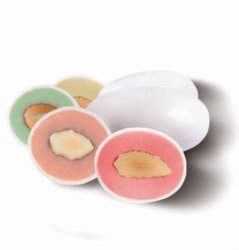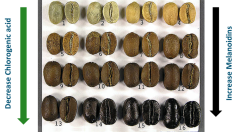Thesis subject
Chocolate & Coffee
Topic 1. Design of functional white chocolate.
Chocolate is a food product that is loved by many because of its desirable qualities. These qualities include a smooth texture that becomes apparent only when the chocolate melts in the mouth. There is however a problem with chocolate in summertime and in most warm tropical countries: chocolate melts. Cocoa butter, the main fat constituent in chocolate, melts at 33.8 _C when cocoa butter crystals are in the stable form.In the literature some strategies to produce heat resistant chocolate have been outlined. Conventional chocolate manufacture consists of the multiple steps: after harvesting, fermentation and sun drying, cocoa beans are then roasted
and ground. The resulting chocolate liquor is then mixed with sugar, extra cocoa butter, milk solids ingredients, emulsifiers, and flavors. The final chocolate should contain around 30% fat, 20% cocoa powder and 50% sugar. If a white chocolate is to be produced, cocoa solids are replaced with whole milk powder or something similar which introduces milk fat and milk solids non-fat into the chocolate.
This thesis project will deal with the step of white chocolate formulation testing different strategies to increase its melting temperature. Study will be designed to test in a systematic manner various hydrocolloids as well as protein and fat sources in order to obtain white chocolate to be used as ingredients in confectionery and bakery sector.

For more information please contact Vincenzo Fogliano.
Topic 2. Food design strategies to add value to the coffee chain.
The Coffee production is still of major importance in the trade between transition countries producing the raw beans and developed countries where most of the roasting and consumption occur. There is a continuous effort to create new business opportunity around coffee with the development of new products such as the coffee capsules for domestic consumption. Roasting and processing of coffee also offer opportunities for differentiate the products and different chemical composition can also lead to different food and health implication
Research questions
Question 1: Can dry separation technology be applied to obtain different coffee products?
Question 2: Can the addition of precursor during wetting influence the formation of melanoidins keeping the same roasting degree ? Are the aroma key odorants influenced by this practice?
Question 3: Which are the key determinant of quality perceived by consumer and how this is related to previous consumption experience (i.e origin country)
Proposed approach
To answer the different research question appropriate methodologies will be used combining chemical and physical analysis with formulation strategies and new processing technique. Focus group and consumer survey will be employed to answer question 3
References
Illy, A., & Viani, R. (1995). Espresso Coffee. The Chemistry of Quality; Academic Press Ed, London.
Vitaglione, P; Fogliano, V; Pellegrini, N. Coffee, colon function and colorectal cancer, Food and Function 2012, 3, 916-922
Fogliano V, Morales MJ. Estimation of dietary intake of melanoidins from coffee and bread. Food and Function 2011, 2, 117-123

For more information please contact Vincenzo Fogliano.